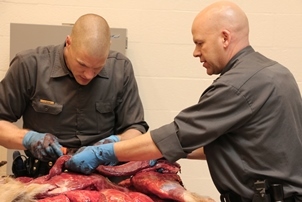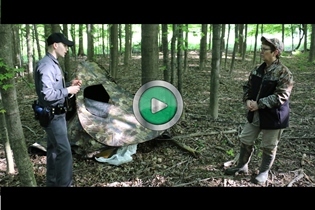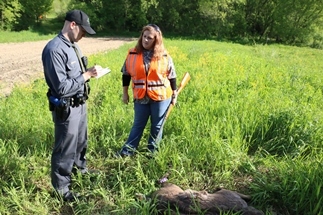Game time – conservation law training
Week 20: May 15-21
Michigan Department of Natural Resources conservation officer recruits go through 22 weeks of intense training at the conservation officer academy. The Michigan Commission on Law Enforcement Standards (MCOLES) requires 594 hours of academy training for all Michigan law enforcement officers. By the time the recruits graduate from the academy, they’ll have completed 990 hours. Many of those additional hours are spent studying conservation law – and this includes week 20 of the academy. Focusing on small and big game identification, enforcement, laws and training scenarios, it was an information-packed week and one in which the 17 remaining recruits will benefit from daily after graduation.
 12-mile hike 12-mile hike
Recruits started the week off strong. They reported back to the academy at 2 p.m. Sunday. Soon after they arrived, the recruits were instructed to report to Sleepy Hollow State Park in Clinton County for a 12-mile hike with backpacks through the park’s trail system, led by 1st Lt. Steven Burton.
“With the recent rain, the trail was wet and muddy, and this benefited the recruits by increasing the challenge,” said Sgt. Jason Wicklund, recruit school commander. “Conservation officers routinely walk miles over many different types of terrain and in all weather conditions, and so this hike was a good endurance test for the recruits.”
Recruits completed the hike in four hours and then enjoyed a cookout.
Watch a short video of the hike.
Wolf, moose and elk
Sgt. Marc Pomroy, supervisor of Dickinson, Iron and Gogebic counties, and Conservation Officer (CO) Brian Bacon of Dickinson County live and work in the middle of wolf, moose and bear county. With a wealth of knowledge and experience investigating large game poaching cases, these officers were well-suited to instruct recruits on big game conservation law.
Recruits spent Monday learning about the habitat and population densities of these big game animals, including corresponding hunting seasons, regulations and enforcement. During instruction by Sgt. Pomroy and CO Bacon, recruits viewed two bear carcasses from the Upper Peninsula. These bears had been illegally killed by poachers. Although the bears were different ages – one a cub and the other a juvenile – they were identical in size.
“Conservation officers must be adept in aging bears for enforcement purposes,” Sgt. Wicklund said. “Habitat and food sources can play a factor in bear growth so size isn’t always indicative of age."
Recruits learned how to distinguish bear cubs from unusually small juveniles.
Small game
Conservation Officer Bobbi Lively returned to the academy Tuesday to instruct the recruits on small game enforcement and education. Small game animals include coyote, pheasant, quail, rabbit and hare, grouse, squirrel and porcupine, among others.
CO Lively brought a large collection of preserved birds and animals. Recruits spent Tuesday and Wednesday learning how to identify each species of small game. They also learned about the species habitats and hunting methods, laws and enforcement of each one.
 Deer, elk and turkey Deer, elk and turkey
Conservation officers Kelly Ross, Montmorency County, and Mark Depew, Otsego County, were guest instructors Thursday for the continuation of big game education. In particular, they covered white-tailed deer, elk and turkey.
Living in the midst of the state’s elk population, and both having successfully investigated a number of elk poaching cases, they offered a wealth of information and experiences to share with recruits.
Necropsies
Thursday afternoon, recruits traveled to the nearby Michigan State University laboratory, the MSU Diagnostic Center for Population and Animal Health, located in Lansing. The DNR utilizes the lab for animal necropsies – autopsies of animals – and investigations. It’s also the location where deer are checked for bovine tuberculosis and chronic wasting disease.
“The MSU lab provided the recruits with animal carcasses, photos, videos and tools to learn how to do necropsies and what to look for in determining cause of death,” Sgt. Wicklund said. “Recruits examined a large number of animals and learned how to properly do an investigation when foul play is suspected.”
After returning to the academy that evening, recruits took an extensive test on animal identification. They also took a written test on small and big game animal laws and enforcement laws.
 Bringing it all together Bringing it all together
Friday the recruits had an opportunity to use what they’d learned in simulated, real-life situations.
More than 30 conservation officers and other volunteers gathered on a wooded property to assist with 10 scenarios. The volunteers served as actors and actresses, playing the roles of bear, deer, coyote and squirrel hunters, among others. These scenarios included situations conservation officers routinely handle, including animal species identification and enforcement, hunting license issues, illegal hunting and trespassing, baiting and safety issues.
View a short video of several of these scenarios.
“It’s important that the recruits experience these scenarios and have a chance, in a controlled environment, to work out any issues they might encounter,” Sgt. Wicklund said. “During the scenarios, conservation officers were on hand to assist recruits with their decisions and methods of enforcement, offering them an individual learning opportunity so they’re prepared when they’re faced with the same or similar situations once they become conservation officers.”
 Each recruit was evaluated on knowledge, officer safety, enforcement action and professionalism. Each recruit was evaluated on knowledge, officer safety, enforcement action and professionalism.
After returning to the Michigan State Police training facility, where the academy takes place, recruits were dismissed for the weekend. With only two weeks left, the recruits are focused on finishing strong and moving on to their next experience, one that would prove equally challenging - 18 weeks of field training and two more specialty schools, basic marine enforcement and waterfowl enforcement weeks.
Subscribe to the weekly conservation officer academy blog, which also is posted weekly on the Michigan DNR Facebook page. View past blogs from Recruit School No. 7.
# # #
/Photo details: Accompanying photos are available below for download. Caption information follows.
Necropsy.jpg: Conservation officers must know how to perform necropsies – autopsies on animals – in order to determine animal cause of death in various circumstances such as poaching.
Bear hunter scenario.jpg: Recruits completed 10 small and big game scenarios, including this scenario involving a bear hunter who wasn’t wearing hunter’s orange. All hunters with firearms must wear at least one item of hunter's orange. The bear hunter was a volunteer who acted out the scenario based on a script.
Deer hunter scenario.jpg: During small and big game training, recruits completed 10 scenarios, one of which involved a deer hunter who had tagged her deer with a friend’s kill tag, which is illegal. The deer hunter was a volunteer who acted out the scenario based on a script./
The Michigan Department of Natural Resources is committed to the conservation, protection, management, use and enjoyment of the state’s natural and cultural resources for current and future generations. For more information, go to www.michigan.gov/dnr.
|


 Deer, elk and turkey
Deer, elk and turkey
 Each recruit was evaluated on knowledge, officer safety, enforcement action and professionalism.
Each recruit was evaluated on knowledge, officer safety, enforcement action and professionalism.




